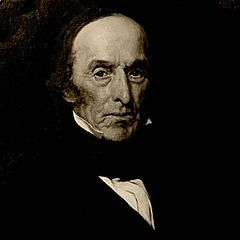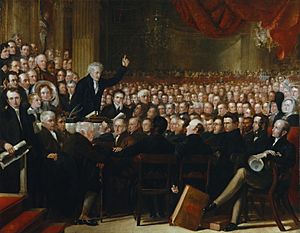John Keep facts for kids
Quick facts for kids
Rev. John Keep
|
|
|---|---|

Reverend Keep in 1859
|
|
| Born | April 20, 1781 Longmeadow, Massachusetts
|
| Died | February 11, 1870 (aged 88) Oberlin, Ohio
|
| Occupation | Reverend |
| Known for | Abolitionism |
| Signature | |
Rev. John Keep (born April 20, 1781 – died February 11, 1870) was an important leader at Oberlin College. He served as a trustee, which is like being on the college's governing board, from 1834 to 1870. Keep was known for his strong support of abolitionism, which was the movement to end slavery. In 1839 and 1840, he traveled to England with William Dawes to raise money for Oberlin College. They also went to a big meeting in London in 1840 to discuss ending slavery.
Contents
John Keep's Early Life and Work
John Keep was born in Longmeadow, Massachusetts, on April 20, 1781. He was one of nine children in his family. He went to Yale College and graduated in 1802.
After college, he taught at a school in Bethlehem, Connecticut. At the same time, he studied theology, which is the study of religious faith. He continued his studies for another year. On June 11, 1805, he became a licensed minister.
Soon after, he started preaching at a church in Blandford, Massachusetts. He stayed there for 16 years. In 1821, he moved to a church in Homer, New York. He left this church in 1833 because some people disagreed with his support for new ways of religious revival. For a year, he preached in Cleveland, Ohio. Then, he helped start the First Congregational Church in Ohio City, which is now part of Cleveland. He became its pastor.
John Keep and Oberlin College
In 1834, John Keep was chosen to be a trustee of Oberlin College. He was very important in shaping what Oberlin College became known for. He strongly supported equal rights for everyone.
Keep believed in rights for women and for black students. He also encouraged students to become missionaries. In 1835, John Keep cast the deciding vote that allowed black students to attend Oberlin College. This was a very big step at a time when many colleges did not allow black students.
Raising Money for Oberlin
In 1839 and 1840, John Keep and William Dawes went on a special trip to England. Their goal was to raise money from people who also wanted to end slavery. Oberlin College was special because it was one of the few colleges in America that allowed both different races and both men and women to study together.
Famous American abolitionists, like William Lloyd Garrison and Wendell Phillips, wrote letters to support their fundraising efforts.

John Keep was at a large anti-slavery meeting in London. He can be seen in a famous painting by Benjamin Robert Haydon. This painting is now in London's National Portrait Gallery. Even though he is partly hidden by other people in the painting, he was there. Keep also met and wrote to important abolitionists in London, like John Scoble and Joseph Sturge.
Keep's Legacy at Oberlin
When Keep returned to Oberlin, he and Dawes had raised $30,000. This was a lot of money back then! John Keep became like a "father" figure to the young women studying at the college. Many of them lived in his house.
John Keep passed away in Oberlin on February 11, 1870. In 1889, Oberlin College bought his house. It was used as a place for female students who needed help with housing. In 1912, the house was rebuilt. Keep's granddaughter paid for the new building. She asked Normand Patton to design Keep Cottage. The new building could house 80 women and had a dining room for 110. Later, in 1966, the rules changed, and the dorms at Oberlin became co-educational, meaning both male and female students could live there.


